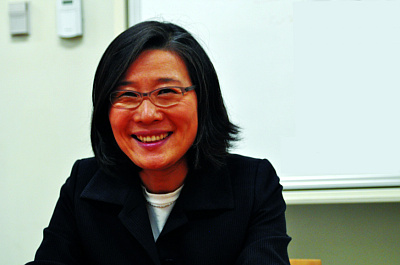
Working in a museum surrounded by thousands of Korean classical arts is always an overwhelming experience for Kim.
“The sensation of Korean classical arts is certainly different from the fascination I have when I encounter revolutionary contemporary arts,” Kim said. “Korean paintings soaked in the peculiar sentiment of Korea attract me all the time. I think that’s what brought me here to the museum, filled with marvelous Korean arts.”
She believes that the “peculiar sentiments” Koreans share, such as the grief of life, and their own way of enduring it humorously are all reflected in the Korean paintings. Korean art is simple, neat and warm without being arrogant, she says.
“Eminent Korean artists all adopted the materials of western paintings. But the message and aura never deserted Korean sentiment,” she said.
Her affection for Korean landscape paintings such as the Paradise, Shangri-La is exceptional. For her, Korean landscape paintings which place the human beings within nature as a part of ecology show the essence of Korean sentiment.
“There’s no need to be overpowered by western masterpieces. We should appreciate the value of our own art.”
“As the new concept for the relationship between human beings and the ecology arises these days, Korean landscape paintings are getting huge attention from the world. The traditional concept of Korean utopia, shown in the paintings, coincides with today’s most advanced model of utopia,” she said.
Even before the world noticed this futuristic aspect of classical Korean arts, Ewha recognized their worth for almost the first time in Korea. Ewha’s pioneer perception in understanding the value of Korean art manifested with the construction of Ewha museum. Ewha established the museum in 1935 with a creed that universities should take a leading role in fostering the culture. For the cause, the museum kept its national heritages even during the chaos of Korean War. Since then, it has been collecting pieces aiming at preserving the “sunbi (Korean classical scholar) spirit.”
“After the Japanese colonial era, many Koreans tended to undervalue their own culture, neglecting thousands of priceless relics. Ewha Womans’ University Museum tried to enlighten the public by showing our graceful and noble sunbi spirit,” she said.
Breathing with the classy Korean relics is inspiration not only for her art, but for her whole life. She says that unlike the sensational arts in western museums like Louvre, the austere style of Korean art calms the visitors down, letting them meditate quietly about their lives.
“There’s no need to be overpowered by western masterpieces. We should appreciate the beautiful aesthetic value of our own art,” she said.
Kim recommends Ewha students visit the museum.
“Visiting museums is just like reading books. The inspiration and the powerful emotion you feel by empathizing with the masterpieces will provide a guidance for life. The museum is a place where creativity and imagination soars,” Kim said. “So, when you seek advices from sages, remember the museum is there, welcoming you with millions of sublime works.”

